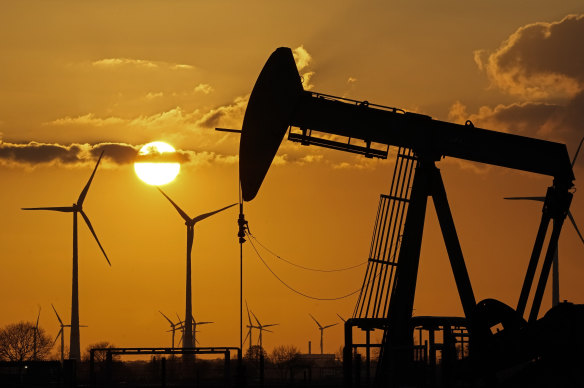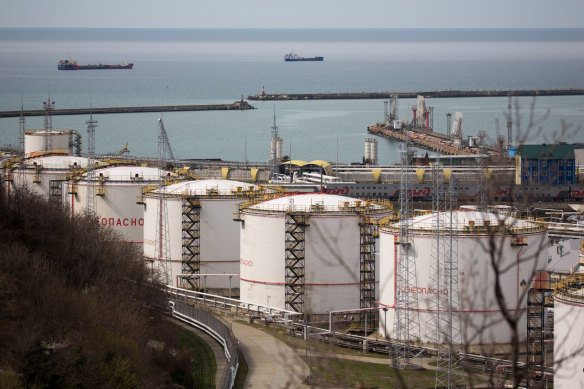
The cartel has, however, struggled to achieve the 5.8 million barrels a day its members agreed to.
A continuing issue for the Saudi-led group has been compliance with the agreed reduction in production by its individual members, with Iraq (about 240,000 barrels a day) Russia (about 200,000 barrels a day) and Kazakhstan (72,000 barrels), in particular, recently producing at levels above their agreed quotas. Angola quit the cartel at the end of last year because of the restrictions on its oil exports.

Non-OPEC members are ramping up their oil production.Credit: AP
Russia, despite promising to adhere to its quotas and volunteering additional cuts, hasn’t met its targets.
That’s partly because its oil sales are the primary source of funding for its war in Ukraine but also because Ukraine has been bombing Russia’s refineries, forcing it to divert supply from its domestic market to exports.
The other major factor complicating OPEC+’s strategies has been increased production from non-OPEC+ producers, particularly the US, where, despite the Biden administration’s environmental policies, which have seen a swathe of Trump-era deregulatory policies reversed and replaced by far more stringent measures to manage environmental and climate-related impacts, production volumes have surged.
Loading
The US is producing at record levels of more than 13 million barrels a day, up from just over 12 million barrels when Biden gained the presidency. That surge in US production, along with increased volumes from other non-OPEC+ producers like Canada and Brazil, has weakened OPEC+’s influence over the market and pushed its share of global production below 40 per cent.
Along with the compliance issues it has experienced within its own membership, whose economies, like its own, are highly dependent on their oil revenues, that has worked against the Saudis’ determination to put a high-level floor under oil prices.
The Saudis themselves are thought to need an oil price of about $US90 a barrel to balance their budget as the kingdom spends vast amounts to diversify its economy away from its dependence on oil.
After posting a budget deficit of $US21.6 billion ($32.4 billion) last year (compared with a $US28 billion surplus in 2022) Saudi Arabia has been borrowing heavily to fund its investment program and last week sold 0.65 per cent of Aramco, its state-owned oil and gas entity, to raise $US12 billion.
The Saudis will be able to bring about a million barrels a day of oil back into production by the end of next year under the new plan. Even then, they’d be producing about 2 million barrels a day below their 12 million barrels a day capacity.

Russia, despite promising to adhere to its quotas and volunteering additional cuts, hasn’t met its targets.Credit: Bloomberg
In the absence of significant growth in demand, the proposed return of production volumes from key producers would weigh on oil prices.
After spiking above $US90 a barrel in early April, after an OPEC+ announcement that the previously agreed cuts would remain in place coincided with a flare up in the hostilities in Gaza, prices have subsided and oil has recently been trading around $US80 a barrel.
The OPEC+ agreement does allow for some fine-tuning of the planned return of some supply if circumstances change and appears dependent on global demand picking up, which would probably require stronger growth in China and global interest rates to fall.
The weaknesses in China’s domestic economy and a slowing of growth in the US have been a dampener on demand and, in the absence of a major fiscal stimulus program in China to boost domestic consumption, which appears unlikely, are likely to continue to weigh on global growth and demand for oil.

The possibility of a second Donald Trump presidency is looming over the global price of oil.Credit: Getty
The OPEC+ plan might also be threatened by events within the US.
There is massive consolidation occurring within the US shale oil and gas sector, with more than $US200 billion of recent transactions, including mega-deals involving the industry heavyweights – Exxon, Chevron, Occidental and, most recently, Conoco Phillips.
That could lead to a further increase in production as their balance sheets and expertise are brought to bear.
Loading
There’s also the spectre of Donald Trump, who has vowed to tear up Joe Biden’s environmental regulations, including its emissions rules and the prohibition on drilling in the Alaskan Artic. He’s also pledged to end the freeze on new export LNG terminals, allow new oil pipelines and speed up the approvals process for more mergers and acquisitions.
If he regains the presidency, the mantra from his first day in office will be “drill, baby, drill,” he has promised, while asking the big oil companies to show their gratitude by donating $US1 billion to his election campaign.
Even without Trump, existing permits would roughly double America’s LNG export capacity over the next three or four years. At the moment it is about 126 billion cubic metres of LNG a day.
The power relationships within the world’s energy markets are changing quite rapidly and will continue to evolve and accelerate as the pursuit of global decarbonisation continues.
Loading
It is the extent of the uncertainties on both the demand and supply sides of the oil market and the energy market more broadly that, along with the financial demands of their own economies, explain why the new OPEC+ gameplan has some flexibility built in.
The members want, as they have throughout the period of the production quotas, to sell more of their oil at higher prices. Circumstances – in the global economy and their own industry – have, to this point, made them choose between volume and price and may continue to do so.
The Business Briefing newsletter delivers major stories, exclusive coverage and expert opinion. Sign up to get it every weekday morning.









 Add Category
Add Category